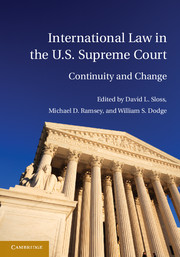Book contents
- Frontmatter
- Contents
- List of Contributors
- Table of Cases
- Acknowledgments
- Introduction
- PART I FROM THE FOUNDING TO THE CIVIL WAR
- PART II FROM THE CIVIL WAR TO THE TURN OF THE CENTURY
- 2 Treaties in the Supreme Court, 1861–1900
- 3 Customary International Law in the Supreme Court, 1861–1900
- 4 International Law as an Interpretive Tool in the Supreme Court, 1861–1900
- 5 A Social History of International Law: Historical Commentary, 1861–1900
- PART III FROM THE TURN OF THE CENTURY TO WORLD WAR II
- PART IV FROM WORLD WAR II TO THE NEW MILLENNIUM
- PART V INTERNATIONAL LAW IN THE U.S. SUPREME COURT IN THE TWENTY-FIRST CENTURY
- V.A TREATIES AFTER 2000
- V.B CUSTOMARY INTERNATIONAL LAW AFTER 2000
- V.C INTERNATIONAL LAW AND CONSTITUTIONAL INTERPRETATION AFTER 2000
- V.D INTERNATIONAL LAW AND STATUTORY INTERPRETATION AFTER 2000
- V.E INTERNATIONAL LAW AND THE WAR ON TERROR
- VI CONCLUSION
- Index
- References
2 - Treaties in the Supreme Court, 1861–1900
Published online by Cambridge University Press: 05 July 2011
- Frontmatter
- Contents
- List of Contributors
- Table of Cases
- Acknowledgments
- Introduction
- PART I FROM THE FOUNDING TO THE CIVIL WAR
- PART II FROM THE CIVIL WAR TO THE TURN OF THE CENTURY
- 2 Treaties in the Supreme Court, 1861–1900
- 3 Customary International Law in the Supreme Court, 1861–1900
- 4 International Law as an Interpretive Tool in the Supreme Court, 1861–1900
- 5 A Social History of International Law: Historical Commentary, 1861–1900
- PART III FROM THE TURN OF THE CENTURY TO WORLD WAR II
- PART IV FROM WORLD WAR II TO THE NEW MILLENNIUM
- PART V INTERNATIONAL LAW IN THE U.S. SUPREME COURT IN THE TWENTY-FIRST CENTURY
- V.A TREATIES AFTER 2000
- V.B CUSTOMARY INTERNATIONAL LAW AFTER 2000
- V.C INTERNATIONAL LAW AND CONSTITUTIONAL INTERPRETATION AFTER 2000
- V.D INTERNATIONAL LAW AND STATUTORY INTERPRETATION AFTER 2000
- V.E INTERNATIONAL LAW AND THE WAR ON TERROR
- VI CONCLUSION
- Index
- References
Summary
From the great tumult of the Civil War to the emergence of a new American empire four decades later, the Supreme Court's record on treaties suggests both continuity and change. Between 1861 and 1900, the Court continued to apply treaties frequently, interpreting them as supreme law that private parties could often invoke, while acknowledging a subclass of treaties that required legislative action before warranting judicial attention. At the same time, the Court's treaty doctrine did change. Instead of disavowing earlier holdings, however, change came via evolution: through more nuanced elaborations of existing doctrine and the creation of new rules for treaty issues that the Court had not previously addressed or resolved.
In terms of continuity, the Court still dealt frequently with treaties; from 1861 to 1900, 136 of its opinions involved some treaty question. The Court regularly applied treaties as law when parties raised claims or defenses that turned – in whole or in part – on treaty provisions. Thus, the Court consistently allowed individuals to make property claims based on perfected titles granted via treaty. At the same time, the Court still declined to apply treaty provisions where it identified jurisdictional or political constraints to judicial review. During the period, the Court also affirmed the notion first articulated in Foster v. Neilson that certain treaty provisions – those deemed “non-self-executing” – require congressional “execution” via legislation in lieu of direct judicial enforcement.
- Type
- Chapter
- Information
- International Law in the U.S. Supreme Court , pp. 55 - 88Publisher: Cambridge University PressPrint publication year: 2011
References
- 1
- Cited by



